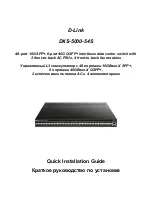
DGS-3710 Series Layer 2 Managed Gigabit Switch Hardware Installation Guide
11
o
RFC 1907 SNMPv2
o
RFC 2819 RMON
o
RFC 2665 Ether-like MIB
o
RFC 2863 IF MIB
o
RFC 2618 RADIUS Authentication Client MIB
o
RFC 2620 RADIUS Accounting Client MIB
o
Private MIB
o
RFC 4363
o
IEEE 802.1X MIB
•
Provides parallel LED display for port status such as link/act, speed, etc.
•
Web-based GUI compatible with Internet Explorer 5.5 or later, Netscape 8.0 or later, and Firefox 2.0 or later
Ports
•
Twelve 10/100/1000Mbps Copper/SFP Combo Ports.
•
One female DCE RS-232 DB-9 console port.
•
One Out-of-Band Management (10BASE-T/100BASE-TX/1000BASE-T) port used for out-of-band, remote IP
access to the Switch.
•
One Alarm port (8 Pin standard RJ45 connector).
Front-Panel Components
The front panel of the Switch consists of LED indicators for Power, System, Alarm, FAN, Management, and a Link/Act
LED indicator for each Copper/SFP port on the Switch. A separate table below describes LED indicators in more
detail.
Figure 1–1 Front panel view of a DGS-3710-12C Switch
The front panel of the Switch contains an AC or a DC power connector. The AC power connector is a standard three-
pronged connector that supports the power cord. Plug-in the female connector of the provided power cord into this
socket, and the male side of the cord into a power outlet. The switch automatically adjusts the power setting to any
supply voltage in the range from 100 ~ 240 VAC at 50 ~ 60 Hz.
Also found on the front panel is a power switch to turn the switch on and off and a console port for the command line
interface management discussed later in this manual. Another port found on the front panel is the Alarm port. This port
is used to detect physical signals from external devices when an alarm event is triggered.












































